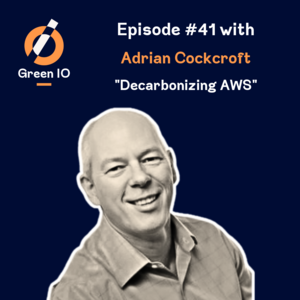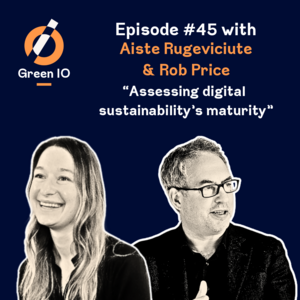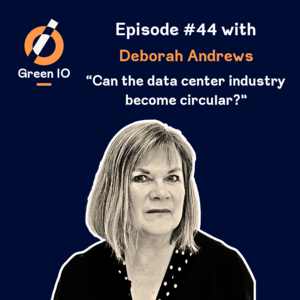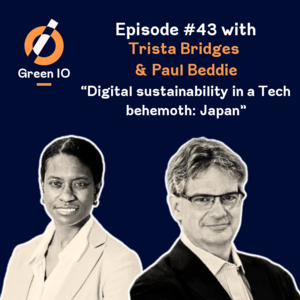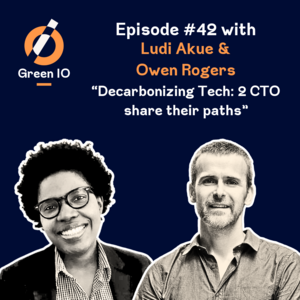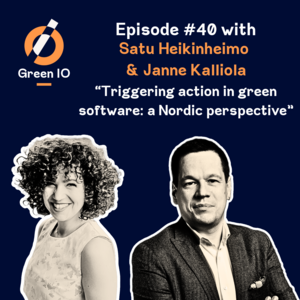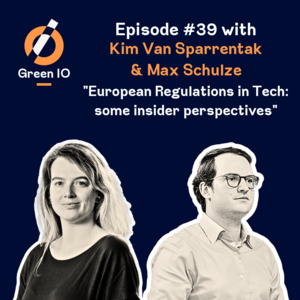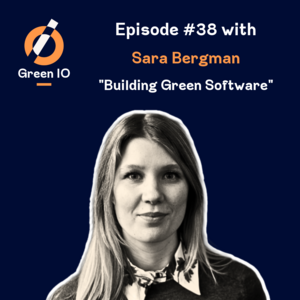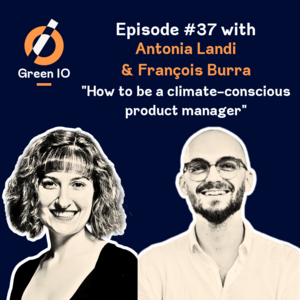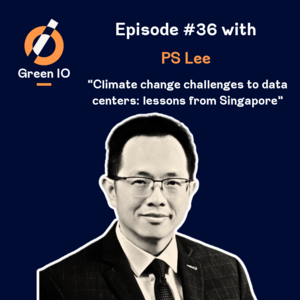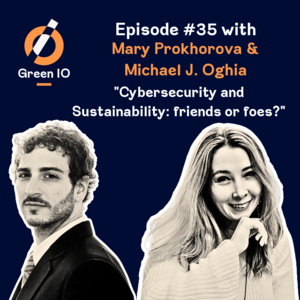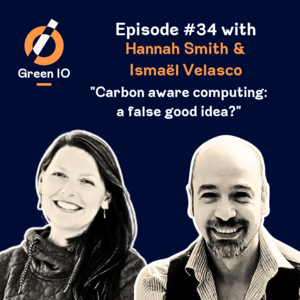#41 - Decarbonizing AWS with Adrian Cockcroft
Update: 2024-06-18
Description
☁️ What can AWS users achieve today in terms of decarbonization? And what can they expect tomorrow?
🎙️ In this episode, Gael Duez welcomes Adrian Cockcroft, the former creator and leader of the AWS sustainability team who now leads the Green Software Foundation project “Real Time Cloud”. They had an in-depth chat about measuring carbon for software and the sustainability challenges of Cloud providers, starting with AWS. Some of Adrian’s takeaways were:
⚡ The case for PPA and market based approach facing the AI energy-hungry boom
☀️ Why we should not chase the sun
🌱 Sustainability of the Cloud vs Sustainability in the Cloud and other architecture tips
☁️ His confidence in getting a standard for Cloud-based GHG emissions
🤝 Why AWS internal structure prevented sustainability to ramp-up and why it should change
… And much more!
❤️ Subscribe, follow, like, ... stay connected the way you want to never miss our episode, every two Tuesday!
📧 Once a month, you get carefully curated news on digital sustainability packed with exclusive Green IO contents, subscribe to the Green IO newsletter here.
📣 Green IO London is on September 19th 2024 --> use the voucher GREENIOVIP to get a free ticket!
Learn more about our guest and connect:
📧 You can also send us an email at contact@greenio.com to share your feedback and suggest future guests or topics.
Adrian’s sources and other references mentioned in this episode:
- Adrian's article "Measuring Carbon is Not Enough — Unintended Consequences"
- CNCF’s Kepler tool
- Green Software Foundation’s project on Real Time Energy and Carbon Standard for Cloud Providers
- Adrian’s presentation at CNCF Sustainability Week in October 2023
- Boavizta’s API
- Digital Collage
- The Sustainability pillar in the AWS Well-Architected Framework
- Cloud Carbon Footprint
- Green Software Foundation
Transcript
Intro 00:00
A video conferencing company used to have an outage every Tuesday morning at 09:00 because that's when everybody wanted a video call at once. Their systems would keel over and they had to go beef them up for that one time of the week when there was a big spike in traffic.
Gael Duez 00:26
Hello everyone. Welcome to Green IO with Gael Duez. That's me. In this podcast, we empower responsible technologists to build a greener digital world, one byte at a time. Twice a month on a Tuesday, our guests from across the globe share insights, tools and alternative approaches, enabling people within the tech sector and beyond to boost digital sustainability. And because accessible and transparent information is in the DNA of Green IO, all the references mentioned in this episode, as well as the transcript, will be in the show notes. You can find these notes on your favorite podcast platform and of course on our website greenio.tech
Before we start, I would love to share a personal anecdote with you. A few weeks ago I had to do a full day of painting in our recently refurbished house and I was happy because I would eventually have the chance to catch up with dozens of podcast episodes that I couldn't listen to in the past weeks. I ended up listening to a fraction of them over the day actually, and it made me realize again how precious our attention is and how dedicating almost 1 hour to a podcast episode is a significant investment of it. And it made me feel sincerely grateful for the thousands of you allocating a precious time every month to listen to Green IO. So in two simple words, thank you and to honor the gift of your attention, today I am going to put on my captain's obvious costume with two statements. AWS remains the biggest public cloud provider worldwide, despite not having that much data on its chinese competitors. I guess it's still a safe bet to say that. Second, IT sustainability experts and environmentally conscious CloudOps working on AWS are not ballistic about the level of services provided by AWS to decarbonize a tech stack, to put it mildly. On the other end, I had the pleasure to meet several AWS employees across Europe highly involved in climate change topics, among others, in trying to move the needle in the right direction internally.
So what can AWS users achieve today in terms of decarbonization? And what can they expect tomorrow? And what is the general trend for the cloud industry when it comes to reducing its environmental footprint in carbon emission and beyond? Now, who would be the best guest to discuss what to expect at AWS and in the public cloud industry at large than the one who created and led the first sustainability team there? And who has been one of the most influential cloud architects of the last decade, as well as one of the managers behind Netflix's highly successful homepage? And before Netflix, having worked in the most iconic tech companies like eBay and Sun Microsystem. And yes, back then it was iconic. Adrian Cockroft, since it's him we're talking about, has retired in June 2022. But he has a very active conception of retirement. He still gives talks, does some consulting gigs and volunteers actively in the Green Software Foundation. So welcome, Adrian. Thanks a lot for joining Green IO today.
Adrian Cockcroft 03:46
Thanks. Thanks for having me.
Gael Duez 03:48
If we put ourselves in the shoes of a CloudOps, a very climate aware CloudOps, what should I do to reduce the carbon emissions of my public cloud use today? And to be a bit provocative, why shouldn't I do nothing? Because this is my cloud provider issue, to become low carbon. And b, the electricity grid is being decarbonized every day a little more. So why should I care? What will you be according to you, the main actions and maybe some hurdles that you should pay attention to.
Adrian Cockcroft 04:23
I think there's two sides to it. The first thing that most people are looking at is measuring their carbon footprint. And it's not just from an academic point of view. It's because your users want to know what their carbon footprint is. So the one thing is that most software companies are in a supply chain. You consume services and you provide services to somebody else. And along with those services in that supply chain, you need to start communicating how much carbon it is. So I think this is one of the areas that people are starting to realize, is that if I know how much carbon to allocate to the activity of my company, then I need to find a way to allocate that, a proportion of that carbon to my customers via some algorithm for doing that. This is one of the areas which is a bit fuzzy, exactly how to do that. There's some fairly simplistic ways of doing it.
So the first thing is measuring, and the reason you're measuring in many cases is because your customers are saying, I need to know how much carbon to allocate as a customer. And then the other side is, once you've measured it, then you can say, okay, where is this carbon coming from? And then I can say, well, most of the carbon is coming from here, so we can do some work to optimize that part of it down. And I'd say that there are, I put companies into two different classes, if you like one of them. And sort of, I have an old physics degree. So the way I like to think of companies that push electrons and companies that push atoms, atoms are much, much heavier and more energy. So if you're moving physical things in the physical world, that's atoms, that's where most of your carbon footprint will be. But if you're a purely software company, you're a SaaS provider. Most of your physical carbon footprint is going to be employees, buildings, but your purpose of your company is to do software.
Software inherently has a pretty light carbon footprint. It's electricity, which is relatively easy to decarbonize. If you're in transport or manufacturing or anything like that, shipping, all of those kinds of things, most of your carbon is going to be somewhere else. So think of whether your company is purely a software company, like maybe a bank, or whether it's a manufacturing or some other kind of company that's moving things around in the world. And then if you're purely software, then most of your carbon footprint will be from your IT stack and you can kind of go in and focus on reducing that. If most of your carbon is from things on the atom side, you may actually want to do more software in order to optimize the hard, you know, the hardware effectively, the physical processes you might want to do run some additional software jobs to optimize scheduling or resource usage in som
A video conferencing company used to have an outage every Tuesday morning at 09:00 because that's when everybody wanted a video call at once. Their systems would keel over and they had to go beef them up for that one time of the week when there was a big spike in traffic.
Gael Duez 00:26
Hello everyone. Welcome to Green IO with Gael Duez. That's me. In this podcast, we empower responsible technologists to build a greener digital world, one byte at a time. Twice a month on a Tuesday, our guests from across the globe share insights, tools and alternative approaches, enabling people within the tech sector and beyond to boost digital sustainability. And because accessible and transparent information is in the DNA of Green IO, all the references mentioned in this episode, as well as the transcript, will be in the show notes. You can find these notes on your favorite podcast platform and of course on our website greenio.tech
Before we start, I would love to share a personal anecdote with you. A few weeks ago I had to do a full day of painting in our recently refurbished house and I was happy because I would eventually have the chance to catch up with dozens of podcast episodes that I couldn't listen to in the past weeks. I ended up listening to a fraction of them over the day actually, and it made me realize again how precious our attention is and how dedicating almost 1 hour to a podcast episode is a significant investment of it. And it made me feel sincerely grateful for the thousands of you allocating a precious time every month to listen to Green IO. So in two simple words, thank you and to honor the gift of your attention, today I am going to put on my captain's obvious costume with two statements. AWS remains the biggest public cloud provider worldwide, despite not having that much data on its chinese competitors. I guess it's still a safe bet to say that. Second, IT sustainability experts and environmentally conscious CloudOps working on AWS are not ballistic about the level of services provided by AWS to decarbonize a tech stack, to put it mildly. On the other end, I had the pleasure to meet several AWS employees across Europe highly involved in climate change topics, among others, in trying to move the needle in the right direction internally.
So what can AWS users achieve today in terms of decarbonization? And what can they expect tomorrow? And what is the general trend for the cloud industry when it comes to reducing its environmental footprint in carbon emission and beyond? Now, who would be the best guest to discuss what to expect at AWS and in the public cloud industry at large than the one who created and led the first sustainability team there? And who has been one of the most influential cloud architects of the last decade, as well as one of the managers behind Netflix's highly successful homepage? And before Netflix, having worked in the most iconic tech companies like eBay and Sun Microsystem. And yes, back then it was iconic. Adrian Cockroft, since it's him we're talking about, has retired in June 2022. But he has a very active conception of retirement. He still gives talks, does some consulting gigs and volunteers actively in the Green Software Foundation. So welcome, Adrian. Thanks a lot for joining Green IO today.
Adrian Cockcroft 03:46
Thanks. Thanks for having me.
Gael Duez 03:48
If we put ourselves in the shoes of a CloudOps, a very climate aware CloudOps, what should I do to reduce the carbon emissions of my public cloud use today? And to be a bit provocative, why shouldn't I do nothing? Because this is my cloud provider issue, to become low carbon. And b, the electricity grid is being decarbonized every day a little more. So why should I care? What will you be according to you, the main actions and maybe some hurdles that you should pay attention to.
Adrian Cockcroft 04:23
I think there's two sides to it. The first thing that most people are looking at is measuring their carbon footprint. And it's not just from an academic point of view. It's because your users want to know what their carbon footprint is. So the one thing is that most software companies are in a supply chain. You consume services and you provide services to somebody else. And along with those services in that supply chain, you need to start communicating how much carbon it is. So I think this is one of the areas that people are starting to realize, is that if I know how much carbon to allocate to the activity of my company, then I need to find a way to allocate that, a proportion of that carbon to my customers via some algorithm for doing that. This is one of the areas which is a bit fuzzy, exactly how to do that. There's some fairly simplistic ways of doing it.
So the first thing is measuring, and the reason you're measuring in many cases is because your customers are saying, I need to know how much carbon to allocate as a customer. And then the other side is, once you've measured it, then you can say, okay, where is this carbon coming from? And then I can say, well, most of the carbon is coming from here, so we can do some work to optimize that part of it down. And I'd say that there are, I put companies into two different classes, if you like one of them. And sort of, I have an old physics degree. So the way I like to think of companies that push electrons and companies that push atoms, atoms are much, much heavier and more energy. So if you're moving physical things in the physical world, that's atoms, that's where most of your carbon footprint will be. But if you're a purely software company, you're a SaaS provider. Most of your physical carbon footprint is going to be employees, buildings, but your purpose of your company is to do software.
Software inherently has a pretty light carbon footprint. It's electricity, which is relatively easy to decarbonize. If you're in transport or manufacturing or anything like that, shipping, all of those kinds of things, most of your carbon is going to be somewhere else. So think of whether your company is purely a software company, like maybe a bank, or whether it's a manufacturing or some other kind of company that's moving things around in the world. And then if you're purely software, then most of your carbon footprint will be from your IT stack and you can kind of go in and focus on reducing that. If most of your carbon is from things on the atom side, you may actually want to do more software in order to optimize the hard, you know, the hardware effectively, the physical processes you might want to do run some additional software jobs to optimize scheduling or resource usage in som
Comments
Top Podcasts
The Best New Comedy Podcast Right Now – June 2024The Best News Podcast Right Now – June 2024The Best New Business Podcast Right Now – June 2024The Best New Sports Podcast Right Now – June 2024The Best New True Crime Podcast Right Now – June 2024The Best New Joe Rogan Experience Podcast Right Now – June 20The Best New Dan Bongino Show Podcast Right Now – June 20The Best New Mark Levin Podcast – June 2024
In Channel

